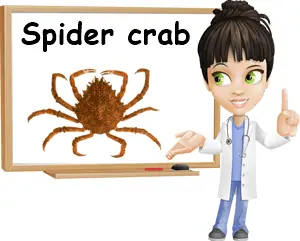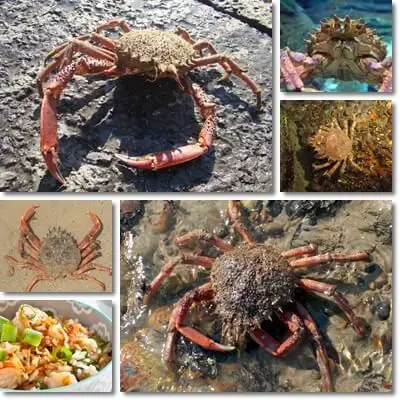The European spider crab (scientific name: Maja squinado) is a species of crab popular throughout Europe and especially in the countries of the Mediterranean basin. Alternative names include spiny or spinous spider crab in English speaking countries or “granseola”, “granceola” or “grancevola” in Italy. The species holds great economic value and the white, flaky, pleasant tasting claw meat is an important source of nutrition, providing excellent amounts of B vitamins, especially vitamin B12, but also phosphorus, potassium, sodium and zinc, protein and healthy Omega-3 fatty acids.
Interesting facts
1) What does the European spider crab eat? The diet of the European spider crab consists of marine plant material such as algae or seaweed (red and brown), insect larvae, sea worms, sea stars or starfish, sea cucumbers, sea urchins and mollusks such as snails, slugs, scallops, oysters etc. and even small fish living on the bottom of the sea floor. The European species is a scavenger just like its relative, the Japanese spider crab.

2) Where does the European spider crab live? The European spider crab is a marine species, meaning it lives in the sea, the Mediterranean sea to be exact. It inhabits caves and crevices or rocky place that can pass as a hiding hole. Alternatively, it stays hidden in the soft seabed. Hiding to avoid predators is especially important during the molting period when the crabs lose their hardened shell. During that time, they also gather and live into groups for protection against predators.
3) What does the European spider crab look like? The species has a large, rounded body, pointier towards the front. The carapace or shell is hard and either brown-orange or red-orange in color, with small, hard bumps or short, spiny projections. The slender legs are brighter orange-red and whitish underneath. The front legs are developed into strong, bulky claws or pincers, an important source of delicious and nutritious meat. An adult spider crab of the species weighs anywhere from 400-500 g to 3 kilograms.
4) What does the European spider crab taste like? The front legs ending in claws are the primary source of meat in the adult European spider crab. The meat is soft and flaky-textured, pleasant-tasting with a faint sweet aroma and overall delicate flavor. It is typically white in color, but can have a red-orange tinge.

Nutritional information
The most notable nutrition facts of the European spider crab:
1) The white claw meat is an excellent source of protein containing all essential amino acids.
2) Generally very low-fat with only about 1% fat and low-calorie with only 80-90 kcal/100 g.
3) Source of Omega-3 fatty acids and cholesterol.
4) High in B vitamins, especially vitamin B12.
5) High in phosphorus, potassium, sodium and zinc.
6) Good source of calcium, magnesium and iron.
7) Crab meat also contains trace amounts of copper, iodine and selenium
List of health benefits
What is European spider crab meat good for? Regular consumption and a reasonable intake contribute to overall good nutrition. By helping meet daily nutritional requirements, European spider crab meat contributes to brain, nervous, muscle, cardiovascular and immune system health and holds benefits for memory and learning, bones and teeth, skin, fertility, mental health and energy metabolism.
1) Good for bodybuilders and anyone looking to gain muscle mass due to a high protein content (between 15-20 g of quality, complete protein per 100 g).
2) Food for the brain, supports memory and learning, good for eating during periods of increased intellectual effort.
3) Potential benefits for mental health. Omega-3 fatty acids in the crab meat have been shown to hold benefits for anxiety and depression, reduce brain fog and improve mood.
The two forms of Omega-3, EPA and DHA, make up cell membranes and are physically part of brain.
4) Anti-inflammatory benefits for the cardiovascular system from Omega-3 fatty acids.
5) Better skin health from Omega-3 fatty acids and other fats, B vitamins and zinc.
6) Minor benefits for thyroid health from iodine and selenium.
7) Benefits for fertility thanks to iodine and selenium which regulate thyroid function and cholesterol which helps produce hormones.
8) Stronger bones and teeth from phosphorus, calcium and magnesium which help maintain good bone density and regulate bone renewal processes. Benefits for osteoporosis prevention.
9) More energy from a varied B vitamin profile (contains vitamins B1, B2, B3, B5, B6, B9, B12).
10) Increased vitality from vitamin B12 and iron.
11) Anti-anemia food. High amounts of vitamin B12 and good amounts of iron combat tiredness, fatigue, muscle weakness and pallor.
12) Stronger immune system thanks to good amounts of zinc and other vitamins and minerals.
13) Satiating, but light food, does not trigger acid reflux and is perfect for an active lifestyle.
14) Low in calories, supportive of a healthy weight (80-90 kilocalories per 100 g).
15) Potential benefits for high blood pressure from good amounts of potassium and magnesium.
Side effects and contraindications
Like all other crustaceans, European spider crab comes with its own set of contraindications and side effects ranging from triggering allergic reactions with the potential for anaphylactic shock to causing food-borne illness in the form of gastroenteritis or parasitic infections, rising blood pressure numbers or cholesterol levels. Side effects are more common in certain categories of people, including those with allergy to crustaceans, hypertension, high LDL or total cholesterol, small children, pregnant women, the elderly or anyone with deficiencies of the immune system.
Below is a beautiful footage of an European spider crab, Maja squinado.
1) Allergic reaction. If you are allergic to crustaceans, then it’s imperative you completely avoid eating European spider crab or other crab species. There is a risk of anaphylactic shock which is a life-threatening condition. If you develop hives (itchy, red bumps on skin) or experience throat itching, a swollen tongue, difficulty breathing, closing of airways, low blood pressure, abdominal pain, vomiting, diarrhea or feel like fainting, you may be having an allergic reaction. These are signs you need to get medical attention immediately.
2) Pregnancy contraindications. If you are pregnant, then avoid eating spider or other crab meat too often or in too large amounts to avoid the risk of heavy metal contamination. Although crab meat is usually low in mercury and other heavy metals, pollution of water sources may increase levels of various contaminants in the meat. If you have pregnancy hypertension, reduce intake and frequency of consumption (crab meat is naturally high in sodium). If you have high cholesterol or cardiovascular problems associated with excess body fat or high cholesterol, avoid eating crab meat or other crustaceans too often. Lastly, if you are pregnant, cook your seafood thoroughly to avoid bacterial or parasitic infections.
3) High in sodium and cholesterol. Contraindicated for anyone with hypertension or high blood cholesterol levels. Regular consumption can accentuate existing health issues and cause side effects for the cardiovascular system.
4) Do not eat crab meat raw. Cook it thoroughly to avoid bacterial or parasitic infections that could lead to gastrointestinal disease or worse, septic shock. Small children, pregnant women, the elderly and anyone with immune system deficiencies are the most at risk for complications caused by eating raw or undercooked crab or other meat.
